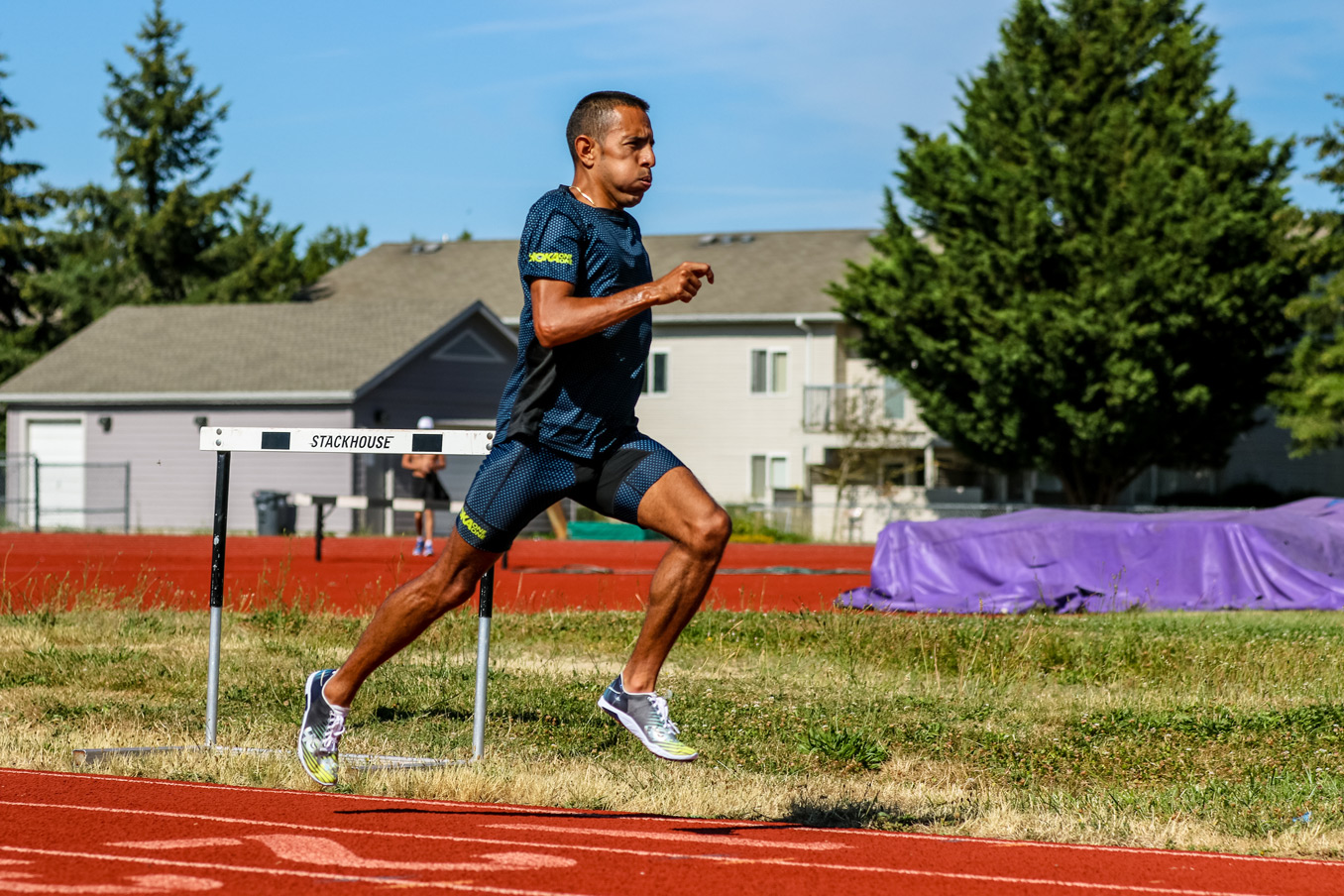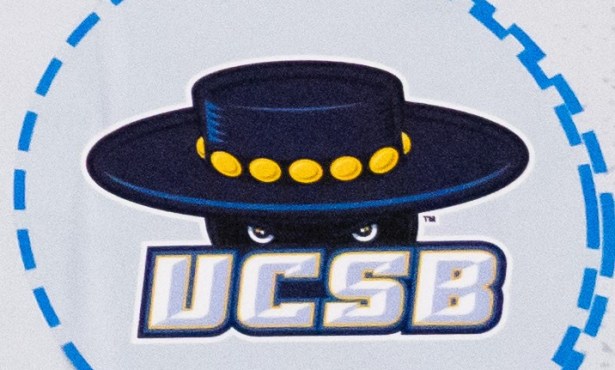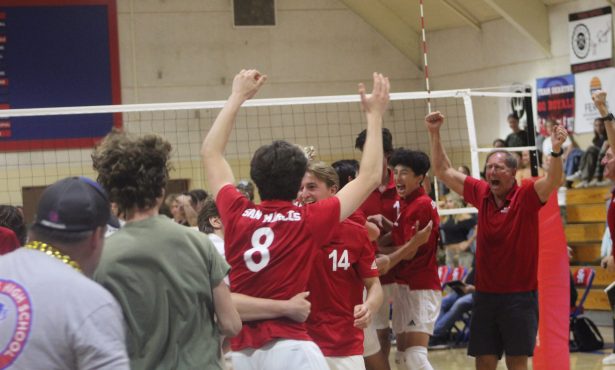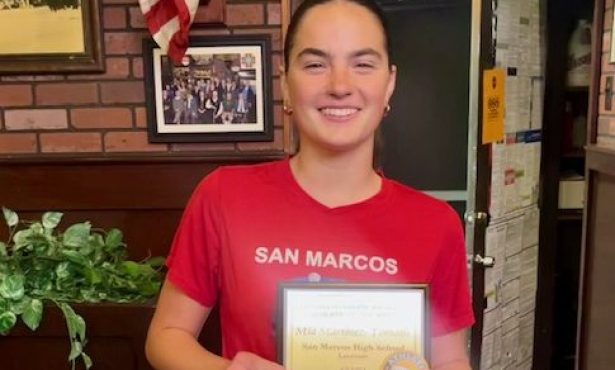Breaking the Four-Minute Mile
SBCC’s La Playa Stadium Hosts Four Elite Running Races Friday Night

Man’s first conquest of the four-minute-mile barrier will soon be 64 years old. It’s about time somebody ran at a faster pace than 60 seconds for four laps around a Santa Barbara track. It’s also timely that it could happen six weeks after the death of Roger Bannister, whose 3:59.4 clocking made history on May 6, 1954.
“Sir Roger, may he rest in peace, broke a mental barrier,” Leo Manzano said. “People thought their heart would explode and they’d die trying to go sub-four. Once he broke through, more and more guys started doing it.”
Track & Field News has compiled a list of 514 Americans who have run the mile faster than four minutes on outdoor and indoor tracks. Nobody has ever officially accomplished the feat in Santa Barbara County, despite its being such a mecca for runners in training that Jim Ryun, the only U.S. miler to break the world record in the past 80 years, lived here for a decade.
That empty box in Santa Barbara’s athletic history could be checked Friday night, April 13. A strong field of milers will toe the starting line at SBCC’s La Playa Stadium in a quest to tear down the four-minute wall.
Manzano is one of the favorites to hit the finish line first. The 33-year-old Texan has compiled an impressive résumé in middle-distance racing, clocking a personal best of 3:50.64 in the mile in 2010, and taking the silver medal in 1,500 meters at the 2012 London Olympics.
Hoka One One, the running shoe company, is Manzano’s sponsor as well as the title sponsor of four elite running events on La Playa’s Nick Carter Track.
At 7:30 a.m., endurance runner Tyler Andrews will attempt to make history in the 50-kilometer run — that’s 125 laps around the track — seeking to better the American record of 2 hours, 52 minutes, 47.5 seconds and possibly the world record of 2:43:38. Andrews, 27, has been training at altitude in Quito, Ecuador.
From 3 p.m. to approximately 8 p.m., SBCC will be hosting a college meet with a full array of track-and-field events.
At 8:40 p.m., “Milers, take your marks.” First, there will be a masters mile in which Santa Barbara’s Aeron Arlin Genet will try to crack the U.S. women’s age 50-54 record of 5:15.55. At 8:50 p.m., it’s the women’s elite mile, in which the goal is to break 4:30. The men’s mile, with at least six runners boasting sub-4:00 credentials, will go off at 9 p.m.
The admission-free festival of miles, which carries prize money of $10,000 and a bonus of $2,000 for barrier breakers, is the brainchild of Cory Smith, a former Villanova University athlete (4:03 personal best) and online running coach. When he moved to Santa Barbara, he was enraptured by “the most beautiful track in the country” at La Playa Stadium. When he found out it had never staged a four-minute mile (the best was 4:01.31 by Jesse Strutzel at the 2001 Easter Relays), Smith said, “I gotta get this done.”
Among the contenders are five milers representing the East Coast club Hoka N.J.*N.Y.: Kyle Merber, who set the collegiate 1,500 record at Columbia and has recorded a 3:52.21 indoor mile; Ford Palmer, who ran five sub-fours in 2015; Graham Crawford, a U.S. Olympic Trials semifinalist in 2016; Travis Mahoney; and Jesse Garn.
Hoping to run his first sub-four is UCSB graduate Shyan Vaziri. He came excruciatingly close as a Gaucho senior in 2016, winning the Elite Mile at UCLA’s Distance Carnival in 4:00.01.
Manzano, if he approaches the form that took him to two Olympics, should be the man to beat. He has a blistering kick, best displayed at the London Olympics, when a 51-second last lap took him from second-to-last to a silver medal in the 1,500.
“There was hardly a glimpse of medaling with a lap to go,” recalled Manzano, the first U.S. runner to medal in the event since Ryun in 1968. “I stayed calm and focused, thinking about my family and friends back home, realizing I may never be here again, and I started passing guys on the last turn … the last 100 meters: ‘I can do it’ … It was surreal.” He finished less than a second behind gold medalist Taoufik Makhloufi of Algeria in 3:34.79.
The 1,500, known as the “metric mile,” was folded into the Olympics in the days that 300-meter tracks were common. Aficionados of the mile, four complete laps around standard 400-meter/440-yard tracks, consider it a much more exciting race, especially because of the four-minute barrier that made Bannister’s feat so memorable. “It has history, glory, and status,” said Ryan Lamppa, a running data specialist in Santa Barbara who founded Bring Back the Mile to advocate including the distance in track meets.
“It’s a beautiful sport, but it can be very tough,” said Manzano, a Mexican American who won four NCAA mile/1,500-meter titles at the University of Texas. After college, he said it’s a struggle to obtain sponsorship. Because of the support he now receives, he said, “I’m feeling pretty good. My training is going well. You have to run fast as well as long, and on race day, it takes a little grit.”
Genet has shown considerable grit in getting herself in shape to tackle the masters mile. The former Cal Poly runner, the director of the County Air Pollution Control District, is a breast cancer survivor, having undergone a double mastectomy in December 2016. “I try to put it out of my mind,” she said. “I’m stronger now than I’ve been in many years. I feel super fit and healthy.”
In the women’s elite mile, several entrants are on the cusp of 4:30, including Megan Moye and Ce’Aira Brown of Hoka N.J.*N.Y., and Raquel Lambdin, a former UC Davis runner from Camarillo. UCSB record setter Jenna Hinkle is also on the entry list.
Santa Barbara does have a claim to fame in the annual State Street Mile, which, because of its downhill course, does not qualify for official records. Lamppa said it has produced 56 sub-4:00 performances, and Michael Coe’s record of 3:49 in 2013 is “the fastest mile run on California soil.”



